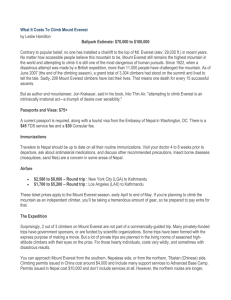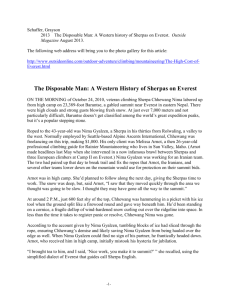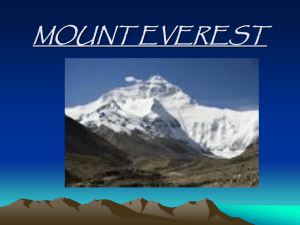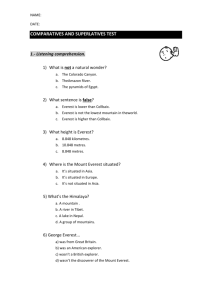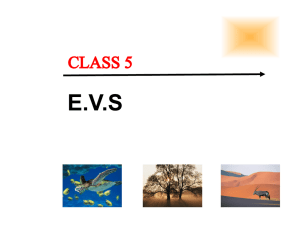Death and Anger on Everest (April 21, 2014)
advertisement
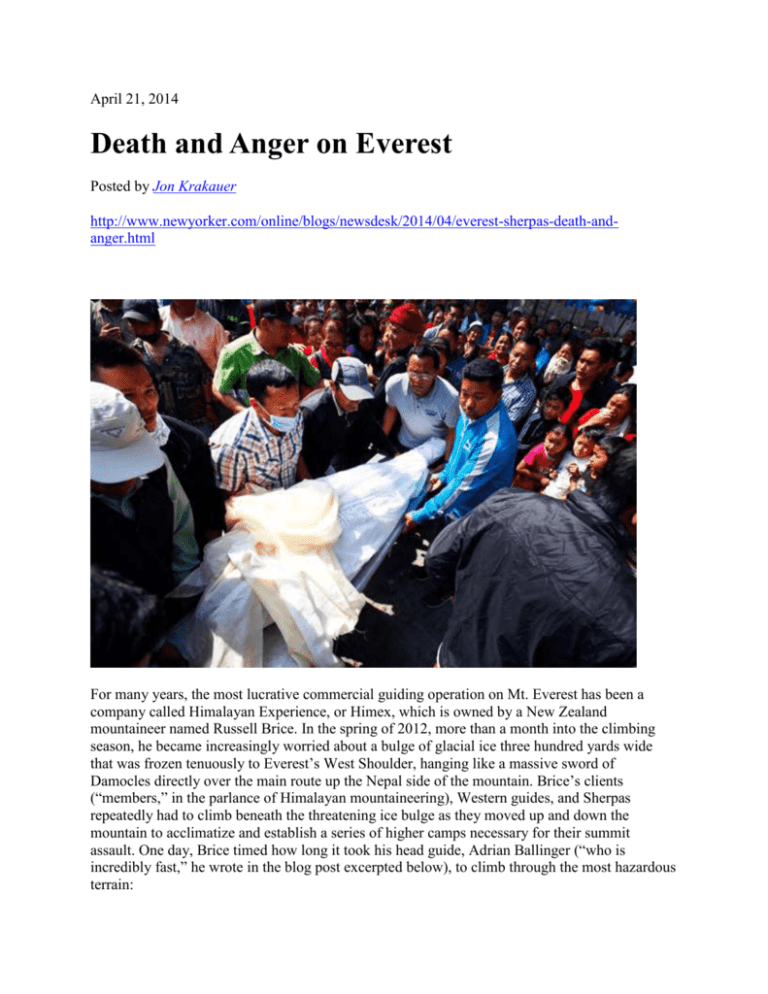
April 21, 2014 Death and Anger on Everest Posted by Jon Krakauer http://www.newyorker.com/online/blogs/newsdesk/2014/04/everest-sherpas-death-andanger.html For many years, the most lucrative commercial guiding operation on Mt. Everest has been a company called Himalayan Experience, or Himex, which is owned by a New Zealand mountaineer named Russell Brice. In the spring of 2012, more than a month into the climbing season, he became increasingly worried about a bulge of glacial ice three hundred yards wide that was frozen tenuously to Everest’s West Shoulder, hanging like a massive sword of Damocles directly over the main route up the Nepal side of the mountain. Brice’s clients (“members,” in the parlance of Himalayan mountaineering), Western guides, and Sherpas repeatedly had to climb beneath the threatening ice bulge as they moved up and down the mountain to acclimatize and establish a series of higher camps necessary for their summit assault. One day, Brice timed how long it took his head guide, Adrian Ballinger (“who is incredibly fast,” he wrote in the blog post excerpted below), to climb through the most hazardous terrain: It took him 22 min from the beginning to the end of the danger zone. For the Sherpas carrying a heavy load it took 30 min and most of our members took between 45 min and one hour to walk underneath this dangerous cliff. In my opinion, this is far too long to be exposed to such a danger and when I see around 50 people moving underneath the cliff at one time, it scares me. Adding to Brice’s concern, some of his most experienced Sherpas, ordinarily exceedingly stoical men, approached him to say that the conditions on the mountain made them fear for their lives. One of them actually broke down in tears as he confessed this. So on May 7, 2012, Brice made an announcement that shocked most of the thousand people camped at the base of Everest: he was pulling all his guides, members, and Sherpas off the mountain, packing up their tents and equipment, and heading home. He was widely criticized for this decision in 2012, and not just by clients who were forced to abandon their dreams of climbing the world’s highest mountain without receiving a refund for the forty-three thousand euros they had paid him in advance. Many of the other expedition leaders also thought Brice was wildly overreacting. The reputation of Himex took a major hit. After what happened last Friday, though, it’s hard to argue with Brice’s call. On April 18th, shortly before 7 A.M. local time, an overhanging wedge of ice the size of a Beverly Hills mansion broke loose from the same ice bulge that had frightened Brice into leaving Everest in 2012. As it crashed onto the slope below, the ice shattered into truck-size chunks and hurtled toward some fifty climbers laboring slowly upward through the Khumbu Icefall, a jumbled maze of unstable ice towers that looms above the 17,600-foot base camp. The climbers in the line of fire were at approximately nineteen thousand feet when the avalanche struck. Of the twenty-five men hit by the falling ice, sixteen were killed, all of them Nepalis working for guided climbing teams. Three of the bodies were buried beneath the frozen debris and may never be found. Although many news reports indicated that all the victims were Sherpas, the legendary mountain people who comprise just half of one per cent of the Nepali population, three of the sixteen were members of other, much larger ethnic groups: one was Gurung, one was Tamang, and one was a member of the Hindu Chhetri caste. All, however, were employed as high-altitude climbing Sherpas—an élite profession that deservedly commands respect and admiration from mountaineers around the world. It was the worst climbing accident in the history of Everest, twice as deadly as the infamous storm in May, 1996, that killed eight people, the subject of my book “Into Thin Air” (four of my teammates accounted for half of that grim tally). But dying on Everest has been an occupational hazard for Sherpas ever since a team led by George Leigh Mallory to attempt the Tibetan side of the peak, in 1922, became the first mountaineers to ascend higher than the lower flanks of the mountain. In the final days of that expedition, seven Sherpas from Darjeeling, India, were swept to their deaths in an avalanche. Sad to say, the job hasn’t gotten any safer for Sherpas with the passage of time. According to a piece by Jonah Ogles posted on outsideonline.com, the death rate for climbing Sherpas on Everest from 2004 until now was twelve times higher than the death rate for U.S. military personnel deployed in Iraq from 2003-07. There is no denying that climbing Everest is a preposterously dangerous undertaking for the members who provide the Sherpas’ income. But running counter to the disturbing trend among Sherpas, climbing Everest has actually grown significantly safer for Western guides and members in recent years, according to the available data. This can be attributed to a number of factors. Western climbers now use bottled oxygen much more liberally than they did in the past; many Western climbers now prophylactically dose themselves with dexamethasone, a powerful steroid, when they ascend above twenty-two thousand feet, which has proven to be an effective strategy for minimizing the risk of contracting high-altitude cerebral edema (HACE) and highaltitude pulmonary edema (HAPE), potentially fatal ailments that are common on Everest; and weather forecasts are much more accurate than they were eighteen or twenty years ago. During the seventy-six years from the first attempt on Everest, in 1921, through 1996, when I was guided up Everest, a hundred and forty-four people died and the summit was reached six hundred and thirty times, a ratio of one death for every four successful ascents. Notably, over the eighteen years that have passed since 1996, a hundred and four people have died and the summit has been reached six thousand two hundred and forty-one times—one death for every sixty ascents. Furthermore, non-Sherpas accounted for only seventy-one of these deaths, which equates to just one death for every eighty-eight ascents. The reason the risk remains so much greater for Sherpas can be traced to several things. Sherpas aren’t provided with nearly as much bottled oxygen, because it is so expensive to buy and to stock on the upper mountain, and they tend to be much better acclimatized than Westerners. Sherpas are almost never given dexamethasone prophylactically, because they don’t have personal physicians in their villages who will prescribe the drug on request. And perhaps most significant, Sherpas do all the heavy lifting on Everest, literally and figuratively. The mostly foreign-owned guiding companies assign the most dangerous and physically demanding jobs to their Sherpa staff, thereby mitigating the risk to their Western guides and members, whose backpacks seldom hold much more than a water bottle, a camera, an extra jacket, and lunch. The work Sherpas are paid to do—carrying loads, installing the aluminum ladders, stringing and anchoring thousands of feet of rope—requires them to spend vastly more time on the most dangerous parts of the mountain, particularly in the Khumbu Icefall—the shattered, creaking, ever-shifting expanse of glacier that extends from just above base camp, at seventeen thousand six hundred feet, to the nineteen-thousand-five-hundred-foot elevation. The fact that members and Western guides now suck down a lot more bottled oxygen is wonderful for them, but it means the Sherpas have to carry those additional oxygen bottles through the Icefall for the Westerners to use. Historically, more Everest climbers have perished from severe weather, HACE, HAPE, exhaustion, falling from steep terrain, or some combination of these hazards than from being crushed or buried in the Khumbu Icefall. This seems to be changing, however. Accurate weather forecasting has reduced the risk of being surprised by a killer storm like the one that struck in 1996. But the pronounced warming of the Himalayan climate in recent years has made the Icefall more unstable than ever, and there is still no way to predict when a serac is going to topple over. And Sherpas spend much, much more time in the Icefall than their Western employers. In 1996, for example, I made four round trips through the Khumbu Icefall: three circuits as I progressively acclimatized to twenty-four thousand feet during the month of April, and a final round trip on my journey to the 29,035-foot summit and back. I was terrified each of the eight times I moved through the frozen chaos, which usually took more than three hours to ascend, even with my nearly empty backpack, and slightly less than an hour to descend. In contrast, each of the Sherpas supporting my team’s ascent was required to make something like thirty trips through the Icefall, often while carrying eighty-pound loads of food, propane, and bottled oxygen. These days, moreover, members are apt to spend even less time in the Icefall than I did when I was on Everest, eighteen years ago. It’s becoming increasingly common for Western guides and members to acclimatize in hypobaric chambers before they arrive in Nepal, or on other, less hazardous Himalayan peaks in advance of their summit assaults, greatly reducing the number of times they must expose themselves to the perils of the Icefall. Some members now make only a single round trip through it, while each of the Sherpas supporting them must still pass through that hazardous terrain between two and three dozen times. Most Western climbers feel more than a little guilty about this, but I know of none who have ever offered to take an extra lap through the Icefall with a heavy load in order to reduce a Sherpa’s exposure. The statistics suggesting that Everest has become safe for members may, in fact, be giving Westerners a false sense of security, however. The astounding number of climbers who now attempt to reach the summit on the limited number of days when the weather is favorable presents a new kind of hazard. A notorious photo shot by Ralf Dujmovits in May, 2012, showed more than a hundred and fifty people attached to a series of fixed ropes as they ascended the Lhotse Face toward the South Col of Everest, jammed together so tightly that they had to move in lockstep. The static weight of all these people and their gear was well over thirty thousand pounds. If some mishap had occurred that caused more than a handful of the climbers to put their full weight on one of the ropes simultaneously, the shock to the anchors securing the ropes to the ice could easily have caused them to fail, resulting in the climbers falling two thousand or more feet to the base of the Lhotse Face. If such an accident should come to pass in the future (which isn’t far-fetched), the death count for both members and Sherpas would be horrific. In any event, no Western members or guides were killed or injured in last week’s avalanche. At the moment, in the immediate aftermath, almost everyone climbing on the Nepal side of Everest has retreated to base camp to try to come to grips with the catastrophe. Most of them, Sherpas and foreign climbers alike, are reeling from the unprecedented loss of life. At least one expedition has already announced that it will abandon the mountain. For the foreign climbers, to go home now will mean forfeiting most or all of the fifty to ninety thousand dollars they have spent to be guided up Everest. For the Sherpas who make the guided ascents possible, however, to quit now, after only a few weeks’ wages, will be an even greater economic sacrifice, relatively speaking. Depending on their talent, experience, foreign-language skills, how many loads they carry up and down the mountain, and how generously they’re tipped by their clients, climbing Sherpas generally take home between two and eight thousand dollars at the conclusion of an Everest expedition, which commences for them in late March and typically ends around the first of June. If a climbing Sherpa dies on the job, his family receives a million rupees (approximately ten thousand five hundred dollars) from the insurance his employer is required to provide. By any reasonable measure, neither these wages nor insurance payouts are fair compensation for the risk involved. But in Nepal, where the median annual income is less than six hundred dollars, most of the Sherpas’ countrymen would eagerly take similar risks for the opportunity to receive that kind of pay. Nevertheless, on April 20th, after holding several emotional, contentious meetings at Everest base camp, the climbing Sherpas announced that they would go on strike unless the Nepali government agreed to meet thirteen demands within a week. The threat of a work stoppage was provoked by the Sherpas’ outrage over the Nepali government’s offer to provide just forty thousand rupees—slightly more than four hundred dollars—to the families of the Sherpas killed in the avalanche, to defray their funeral expenses. Among the Sherpas’ demands are that the government increase this compensation to approximately a thousand dollars per family; provide ten thousand dollars to climbing Sherpas who have been seriously disabled; establish a permanent relief fund for injured Sherpas with a portion of the ten-thousand-dollar permit fee every Western Everest climber is charged by the Nepali government; double the current insurance benefit provided by the guiding companies to twenty-one thousand dollars; require the guiding companies to pay Sherpas their salaries, even if they call off the remainder of the 2014 Everest climbing season; and establish a monument in Kathmandu to memorialize the deceased Sherpas. The collective anger and resentment expressed by the Sherpas over the past few days is unprecedented. On April 20th, Tim and Becky Rippel, the owners of a guiding company called Peak Freaks, which lost a Sherpa named Mingma Tenzing to a fatal case of HAPE earlier in the month, stated, in a blog post: As we suggested in a previous post the Sherpa guides are heating up, emotions are running wild and demands are being made to share the wealth with the Sherpa people on the table. Now that there are more Sherpa operators today on Everest, they’ve come to learn how much the government of Nepal makes in revenues from Everest expeditions and they are asking for a share. This is their time and under very unfortunate circumstances.… In any case things are getting very complicated and there is a lot of tension here and it’s growing.… Peak Freaks is in support of the Sherpa people any which way it goes. They are our family, our brothers and sisters and the muscle on Everest. We follow their lead, we are guests here. Should the government and the Sherpas manage to reach an agreement concerning the terms of the new demands, it will come as no great surprise if most of the Sherpas now grieving intensely for their absent companions resume their dangerous work within the next week or two. Many people believe that this is the most likely outcome. Jon Krakauer’s most recent books are “Three Cups of Deceit,” “Where Men Win Glory,” and “Under the Banner of Heaven.” Photograph by Niranjan Shrestha/AP.
